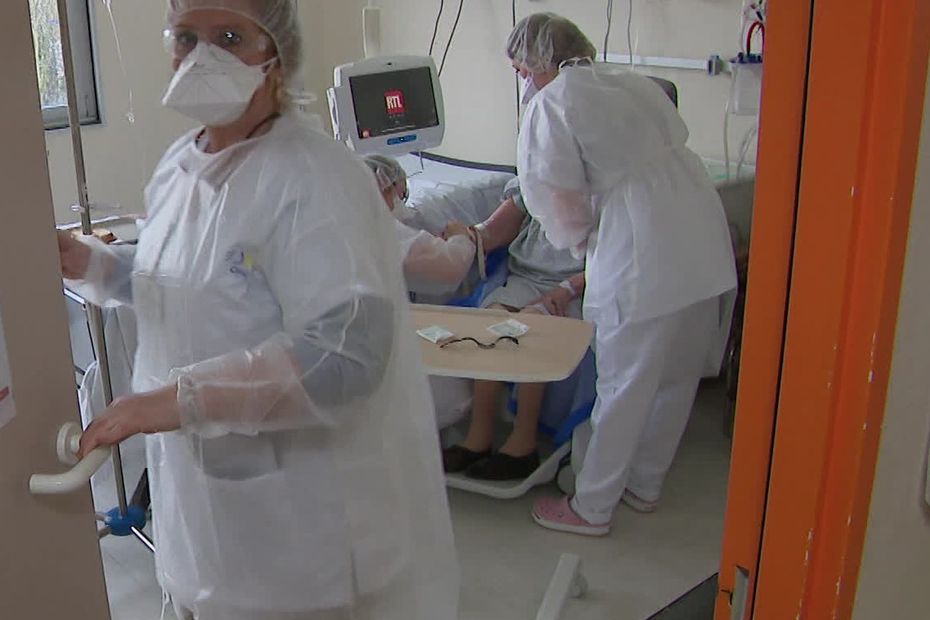A wide angle to be found in our 7 p.m. news on Saturday February 20 and in replay: our teams were able to spend a few hours in the intensive care unit of the Salengro hospital and the COMED unit of the Calmette hospital in Lille.
–
Continuous beeps in the background, the eight caregivers of the medical team take stock of each patient’s door. It is 10 a.m. this Monday morning, the head of the intensive care unit of the Salengro hospital in Lille, Doctor Anahita Rouze, notes the developments of the night for her 35 positive for coronavirus. For this patient “on a wire”, The night was not good.
“Resuscitation is really a team effort”, Explains this resuscitator. “When one of them is in respiratory distress, we should all be together at the bedside. Our goal is for them to get out of here with as little damage as possible”.
After these team meetings, you have to put on the charlotte, the duck mask, the overcoat and the glasses before entering a room. So much protection to keep them out of reach of the coronavirus, so many steps in the preamble before being able to exercise their profession and to treat, explain and reassure.
“If your children are worried, we can arrange a visit”, Indicates the manager to the attention of a patient. The members of the healthcare team then repeat the same ritual before moving on to another patient: you have to undress, disinfect your hands, and wear the same protections, tirelessly.
Only 7 places available on the 62 intensive care beds
That Monday, there are only 7 places available on the 62 intensive care beds. A tension on the possibility of welcoming new patients which does not show any “real growth in peak cases as we could live as during the first and second vague ”, explains the manager calmly. “For the past few weeks, it has been a very slow rise which has forced us to very gradually increase our capacity to accommodate severely affected patients.”, She adds.
Chantal Moudart has just left the intensive care unit at 77. She joined the COMED of Calmette hospital in Lille, a conventional hospital service which also welcomes Covid patients, and which acts as an adjustment valve. The 30 places available bring together all those who do not need to go to intensive care, who could go there or who are leaving. The septuagenarian explains, still a little out of breath and still on respiratory assistance, having been admitted to the hospital with her companion three weeks ago.
I don’t understand how we could have caught it
His, “diabetic and cardiac”, Did not survive. “They took me once to see it, we were on the same floor. We held hands, but I don’t know if he really recognized me. He was moaning so much”. Yet, she adds, “since last March, they hardly went out, had their groceries delivered, and no longer saw their children“.
“I don’t understand how we got hold of it “, she wonders. I was so careful. I disinfect everything. But even while protecting themselves, no one is immune”. Today, the septuagenarian is better: “I’m afraid to come home and find myself all alone, but I will have to come home one day. ” His next step: going to a rehabilitation center to learn to walk again.
It is precisely the last day of Muriel HOTTE, another COMED patient. Contaminated with the British variant, she had a pulmonary embolism, but was able to avoid resuscitation. After a week of treatment for Covid-19, she is cured. Her husband, very moved, comes to pick her up.
“No one was a ‘covidologist’. Everyone was forced to learn. “
“We had to learn on the job”, Explains this physiotherapist responsible for gently reworking muscles that have remained inactive during the days of resuscitation. “No one was a “covidologist”. Everyone was forced to learn. Covid-19 is a disease that we did not know. We are starting from scratch, with patients who had severe forms. When we see those who are doing well, for us, it is the very essence of our profession”, Explains this specialist.
For Dr Rouze, who heads the intensive care unit, there is only one way out of the health crisis: “My ray of hope is vaccination. We heal, and we will heal people to the end. Until a sufficient number of people are vaccinated.”
–


